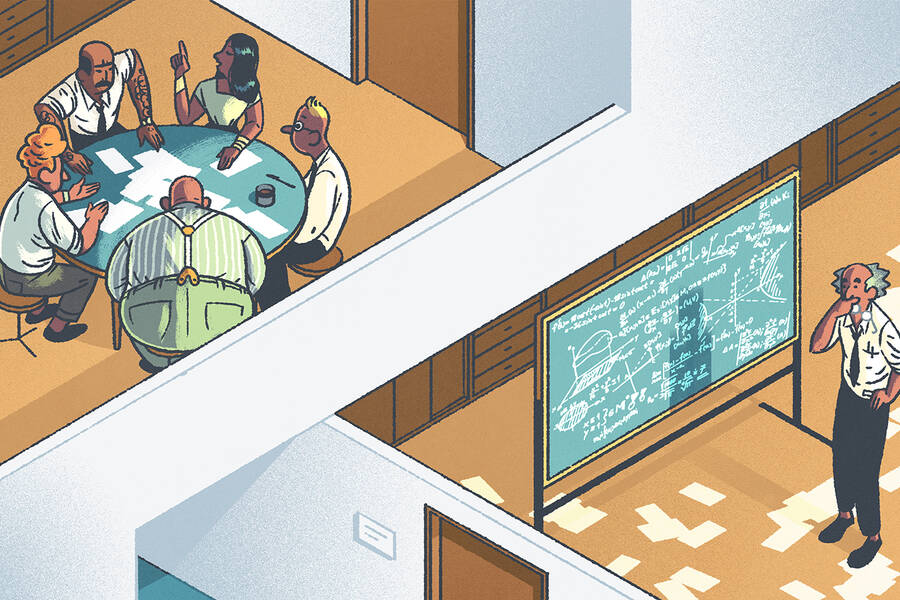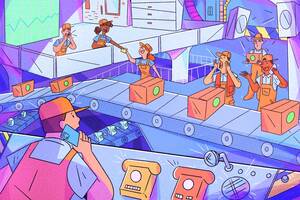But over time, as technology has improved, we have gotten better at collecting and analyzing data. A lot better. In response, a new approach to making sense of complicated phenomena—a new scientific discipline, really—has started to take off. That discipline is called complexity science.
When faced with a complex problem—like how the oceans will respond to climate change, or how the neurons in our brain communicate with one another, or how traffic might best be routed through a quickly growing city—complexity science encourages a holistic view. Rather than breaking the problem into tiny parts and studying each of them separately, you can analyze the system as a whole.
And if this all sounds a little abstract, like something businesses don’t need to think about at all, think again—because markets and organizations are complex systems, too.
In 2023, Kellogg launched the Ryan Institute on Complexity, cofounded by three Kellogg professors with very different academic backgrounds: Brian Uzzi (a sociologist by training), Dashun Wang (a “reformed physicist”), and Ben Jones (an economist).
Kellogg Insight recently recorded a podcast, airing February 19, with Uzzi, Wang, and Jones. On it, we discuss why complexity science’s time has come, and why you should be paying attention. Here are some highlights from that conversation, edited for length and clarity.
On why it’s so important to analyze the entirety of a system
Dashun WANG: The canonical example is to think about a flock of birds. If you look at the flock of birds, you realize they go together almost like an organism, but there is no middle manager in that flock. There is no CEO. But as a whole, they exhibit a kind of property that no individual bird can. Individual birds actually can achieve very little; as a flock they have a competitive advantage. Then they can go after food sources that individual birds couldn’t.
On what counts as a system
Brian UZZI: In complex systems, the boundary of the system is always an issue because it’s somewhat subjective as to where you want to define it. So if you’re looking at a rock and roll band, is it the five people in the group? Is it the group plus the producer on the album plus the record label that markets it? You can open and close the boundaries and see different things depending on where you begin and end.
WANG: Or another way I look at is: everything’s a system, it’s just at a different scale. A team is a system of different minds working together. Every mind of every brain is a system that’s billions of neurons.
On the importance of bringing an interdisciplinary perspective to studying systems
Ben JONES: One thing that unifies us is trying to understand where big breakthroughs in technology, innovation, and science come from. I’m going to come at that with a certain kind of economic frame. Brian’s going to come at that with more of a sociology frame, which is going to emphasize more network orientation, more social context. And Dashun might come at it with models that are from physics but are analogous to human behavior. And so when we work together, we are able to open up our conceptual orientations and come at a question in a more novel way, because we can listen to each other and find new and broader ways of thinking.
On what a “systems approach” can tell us about one topic businesses are likely to care a lot about: innovation
JONES: Is an R&D team like a string quartet or is it more like the copilots in the cockpit of a plane?
If you had four pilots, two really good and two sketchy, and two planes, would you want to put the sketchy pilots together or would you want to split them up between the good pilots? You would want to put a good pilot in each plane. You would not want to put the sketchy pilots together because you want to make sure that each plane has at least one good pilot, right? Because effectively the quality of the plane flying is going to depend on the best person in the cockpit. So you don’t want to have only bad people in the cockpit.
But let’s say I’m trying to build string quartets. Do I want to spread my sketchy musicians around? I do not. Because one sketchy member on the quartet is going to ruin the whole sound: if someone’s playing off time or off tune, it’s going to ruin the whole effect. So what you’d actually like to do is isolate problem cases, and you want your best people working together.
Okay, now go to an R&D team in an organization. You’ve got a couple of people who have really great ideas. Do you split them up? Or do you want to put them together? So we studied this, looking at large-scale data and watching what happens as people move around from different teams. You see how they perform in different contexts.
It turns out that R&D teams look a lot like string quartets, not like pilots. So, in other words, you actually don’t want to spread your best people around. You’d rather have them work together. And this gets back to people being specialized. In a modern R&D situation, people are bringing specialized skills into teams, and if you have a weak link in one of the specialists, they can cause the whole project to be defeated.
On why the time for complexity science is now
WANG: If we boil it down to two major factors, it’s data and tools. I think on the one hand there is this large amount of data that captures many aspects of business and a range of human behavior: this data has now become available in a way that it was hard to imagine 10 years ago or 20 years ago. So just the unprecedented level of access that we have to data.
But at the same time, I think what is often overlooked is the availability of tools that can help us make sense of this data. And these tools include complexity science and networks as a tool, as well as large language models or AI as a tool. You can then borrow these kinds of tools to ask very fundamental social-science questions that otherwise we couldn’t.
On their goals for the Ryan Institute on Complexity
WANG: Complexity science has won the Nobel Prize in physics, but in terms of applying it to business and social science, we’re just at the beginning. We’re really just scratching the surface.
Traditionally, social-science research has been individual faculty members working in their offices. But one of the things we’re hoping to do with the Ryan Institute is to bring the kind of lab model that exists in the hard sciences into the social sciences. Hopefully this will enable faculty members at Kellogg, as well as at the university, to more readily establish new collaborations, scale faculty’s time, work together on bigger problems, and attack those problems faster.
JONES: Today, we have so much more extent knowledge, technical knowledge, scientific knowledge about how to do things. And so you just can’t be an expert as easily as you were in the past. The Wright brothers were two brothers who produced the first airplane, and they’re both considered leading aeronauts of their time. They’re conceiving of the plane, they’re designing it, they’re building it, they’re even flying it. And that’s just two people, and they’re able to make this work. But a modern airframe, like an Airbus or a Boeing 787, just the jet engines are 30 different PhD-level disciplines. And that’s just the jet engines!
UZZI: As scientists and people trained to solve problems see a smaller piece of the world, they’re also equipped to only solve problems involving a smaller piece of the world. But the problems have gotten bigger and more complex and global in nature. And the only way to make it work is you’ve got to put people back together in a network. The Ryan Institute is an incredible opportunity to be part of trying to define that future.



